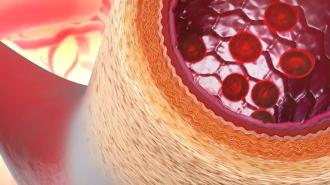Appropriately enough for Halloween, there’s a whole subsection of research out there that blends the synthetic and the natural, blurring the edges of life itself.
Into this uncanny canon comes a consortium of scientists, led by researchers from the University of Sydney, who have developed a way to manufacture living blood vessels.
These could play an important role in surgeries that require synthetic blood vessels, especially in children.
Researchers have developed a way to manufacture living blood vessels.
“Currently when kids suffer from an abnormal vessel, surgeons have no choice but to use synthetic vessels that function well for a short time but inevitably children need additional surgeries as they grow,” Christopher Breuer, a study co-author from the Columbus’ Center for Regenerative Medicine at Nationwide Children’s Hospital and the Wexner Medical Center, said.
“This new technology provides the exciting foundation for the manufactured blood vessels that […] continue to grow and develop over time.”
The team’s technique, published in Advanced Materials, consists of a tube containing fibers of “tropoelastin” — a building block of the protein elastin, which, appropriately enough, is what makes blood vessels elastic.
Cells and extracellular matrix, a scaffolding made of proteins, sugars, and other molecules grow on the tube, eventually creating a complex, very close approximation of the body’s natural blood vessels.
“Nature converts this manufactured tube over time to one that looks, behaves and functions like a real blood vessel,” Anthony Weiss, senior author and professor of biochemistry and molecular biotechnology, said.
That’s key, because blood vessels aren’t just simple straws. They are made from rings of elastin, which helps them expand and contract with blood flow. The structure of the synthetic tube allows for these ring formations to form naturally.
When implanted into the abdominal aorta of a mouse — in humans, the largest blood vessel in the body — the tube developed structures within eight weeks; by eight months, it had a structure comparable to a natural mouse abdominal aorta — a “neoartery.”
“These synthetic vessels are elegant because they are manufactured from just two naturally occurring materials that are well-tolerated by the body,” bioengineer and lead author Ziyu Wang said. Wang, building off the work of Sydney’s Suzanne Mithieux, developed the technology for his PhD.
“Nature converts this manufactured tube over time to one that looks, behaves and functions like a real blood vessel.”
Anthony Weiss
According to the authors, the tube is able to be manufactured quickly with well-defined parameters, and could be kept in a sterile plastic bag until it is needed. And creating living blood vessels, they believe, could just be the beginning.
“The technology’s ability to recreate the complex structure of biological tissues shows it has the potential to not only manufacture blood vessels to assist in surgery, but also sets the scene for the future creation of other synthetic tissues such as heart valves,” Weiss said.
We’d love to hear from you! If you have a comment about this article or if you have a tip for a future Freethink story, please email us at [email protected].






